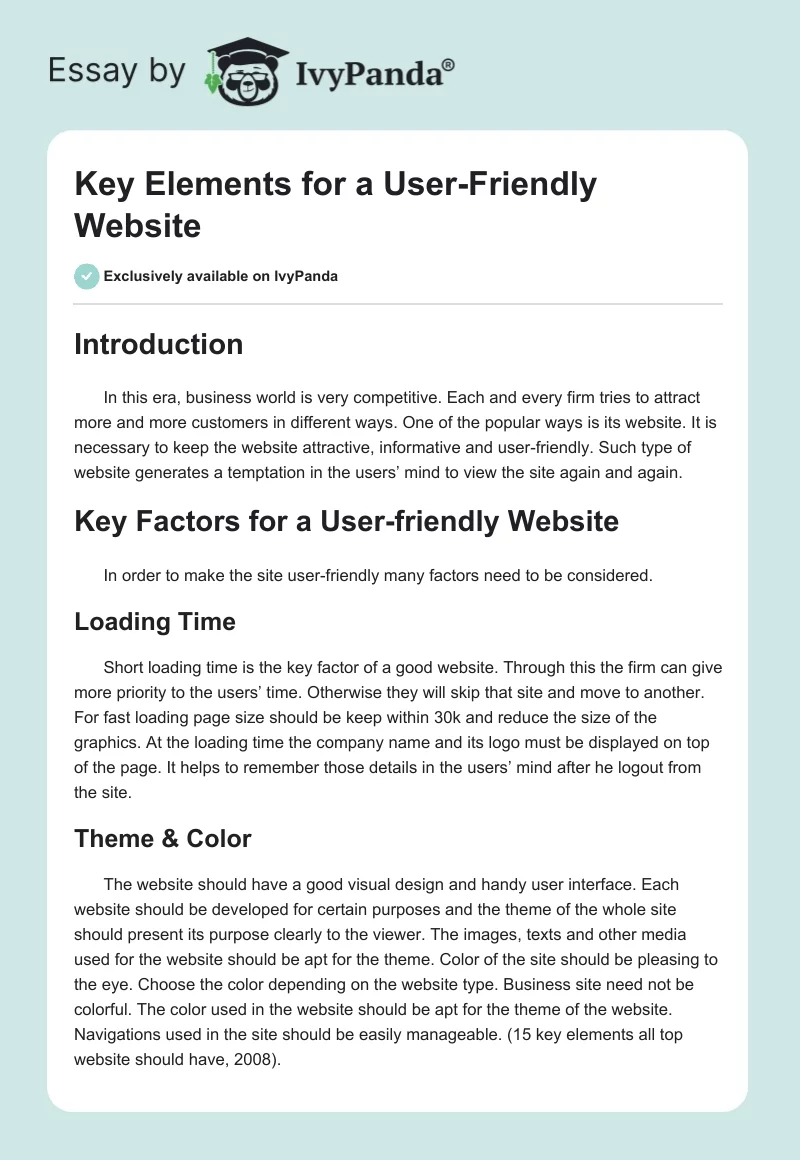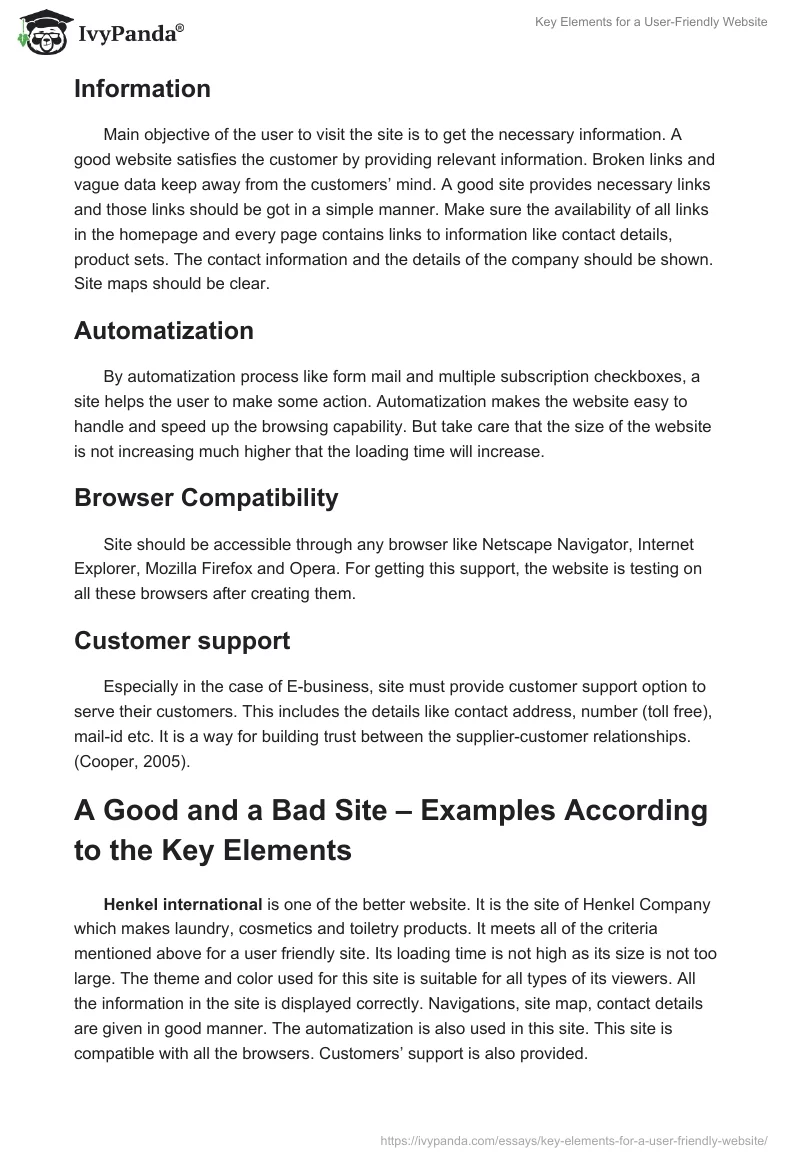Introduction
In this era, business world is very competitive. Each and every firm tries to attract more and more customers in different ways. One of the popular ways is its website. It is necessary to keep the website attractive, informative and user-friendly. Such type of website generates a temptation in the users’ mind to view the site again and again.
Key Factors for a User-friendly Website
In order to make the site user-friendly many factors need to be considered.
Loading Time
Short loading time is the key factor of a good website. Through this the firm can give more priority to the users’ time. Otherwise they will skip that site and move to another. For fast loading page size should be keep within 30k and reduce the size of the graphics. At the loading time the company name and its logo must be displayed on top of the page. It helps to remember those details in the users’ mind after he logout from the site.
Theme & Color
The website should have a good visual design and handy user interface. Each website should be developed for certain purposes and the theme of the whole site should present its purpose clearly to the viewer. The images, texts and other media used for the website should be apt for the theme. Color of the site should be pleasing to the eye. Choose the color depending on the website type. Business site need not be colorful. The color used in the website should be apt for the theme of the website. Navigations used in the site should be easily manageable. (15 key elements all top website should have, 2008).
Information
Main objective of the user to visit the site is to get the necessary information. A good website satisfies the customer by providing relevant information. Broken links and vague data keep away from the customers’ mind. A good site provides necessary links and those links should be got in a simple manner. Make sure the availability of all links in the homepage and every page contains links to information like contact details, product sets. The contact information and the details of the company should be shown. Site maps should be clear.
Automatization
By automatization process like form mail and multiple subscription checkboxes, a site helps the user to make some action. Automatization makes the website easy to handle and speed up the browsing capability. But take care that the size of the website is not increasing much higher that the loading time will increase.
Browser Compatibility
Site should be accessible through any browser like Netscape Navigator, Internet Explorer, Mozilla Firefox and Opera. For getting this support, the website is testing on all these browsers after creating them.
Customer support
Especially in the case of E-business, site must provide customer support option to serve their customers. This includes the details like contact address, number (toll free), mail-id etc. It is a way for building trust between the supplier-customer relationships. (Cooper, 2005).
A Good and a Bad Site – Examples According to the Key Elements
Henkel international is one of the better website. It is the site of Henkel Company which makes laundry, cosmetics and toiletry products. It meets all of the criteria mentioned above for a user friendly site. Its loading time is not high as its size is not too large. The theme and color used for this site is suitable for all types of its viewers. All the information in the site is displayed correctly. Navigations, site map, contact details are given in good manner. The automatization is also used in this site. This site is compatible with all the browsers. Customers’ support is also provided.
Haven works is a worse site. The size of the website is large. The visual design is in a least eye-catching manner. It has dark color that makes the site dirty. All the data and links are scattered throughout the page. It is not at all user-friendly. Navigation is not easy in this site. (Season’s savings, 2009) is the full URL of the Dell Computer’s USA branch. It satisfies almost all criteria for a best site. When one enters its URL in any web browser it will load quickly. At the homepage itself the company logo is displayed on the top left-hand corner in a nice manner. There are many links in the homepage which are arranged in a special way which is attractive and easy to see. So we never feel there is bulky of links and data are distributed in the page. On the first click itself the corresponding page is displayed and is done rapidly. All the pages in this site are very eye-catching and its color settings (there is no special color) and flash settings are also pleasing to the eyes. Necessary graphics are also their. Each page contains essential links and in each page has company’s logo. There is no broken links in this website. Online shopping is also possible through this site. It is one of the most required services in this period. So it will generate a temptation in one’s mind to visit this site again and again.
Lacie 500 GB External HDD is the full URL of the Plaisio Computers. It is not a user-friendly site. Almost all information in this site is given in Greek language. So visitors who are not familiar in Greek cannot read basic information from this site. Links are also given in Greek language. So moving from one page to another page is also very difficult. Due to these reasons a person never visits this site more than once.
Conclusion
For getting more attention, today’s websites are looking for different technologies and themes. As the speed of the Internet connection increases, the use of high-end technologies becomes a common thing. More images, videos, sounds and flash works in websites are becoming common today. All the new technologies will enhance the usage and the area of usage will become wide.
References
Cooper, David. (2005). Ten steps to a more user friendly website. Webpronews. Web.
Haven works. (2009). Haven Works.com. Web.
Henkel international. (2009). Henkel. Web.
Lacie 500 GB External HDD. (2008). Web.
Season’s savings. (2009). Dell. Web.
15 key elements all top website should have. (2008). Freelancefolder. Web.


